The Ministry of Education and Science is creating a "Russian Kickstarter" to finance R & D
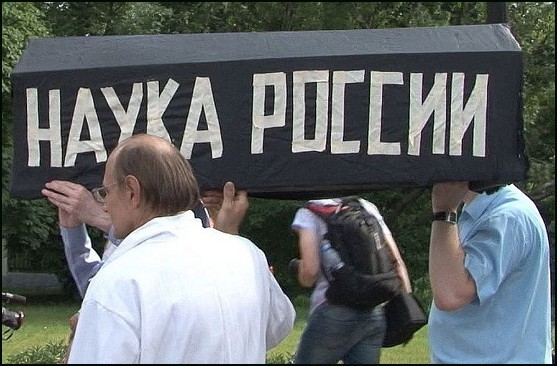
There are still young and promising scientists in Russia, but the conditions for their work are not the best. Funding money is not always enough. Officials do not really understand what research areas should be financed in the first place, and the infrastructure of venture investments is practically absent. As a result, it is easier for young scientists, inventors and entrepreneurs to leave the country and launch a startup abroad, where they will attract venture investments and grants to their idea and will be able to continue working.
The Ministry of Education and Science of the Russian Federation offers a way out. The country should be saved by a platform of scientific and technological integration, planning and ordering research (for simplicity, we will call it abbreviated - PNTIPZI).
According to Sergey Matveev, Deputy Director of the Department of Science and Technology of the Ministry of Education and Science, with the help of PNTIPS, young scientists will find a potential investor for their project.
')
PNTIPZI will perform two functions:
- for research teams - search for a potential investor for the project;
- for business - search for implemented or potentially successful and interesting scientific developments.
Everything is very simple. In fact, in the state Russian system, PNTIPZI implement the standard crowdfunding model, which has proved its success on the example of Kickstarter and other crowdfunding sites.
Officials believe that investments for Russian inventions can be found without difficulty. In their opinion, there are a lot of good inventions, just investors don’t know about them: “In recent years, Russia has consistently built up a accounting system that reflects the results of research and development carried out with the involvement of budget funds,” said Sergei Matveyev. “Today, the general database contains information on about 1.5 million R & D, tens of thousands of research results, including those protected by national and foreign patents.”
One and a half million inventions have been registered, but cannot be implemented, because investors simply do not know about them. The service platform PNTIPZI will solve this problem by arranging the exchange of information between investors and inventors.
As the official explained, any inventor can apply for financing through PNTIPZI (that is, put up his lot) if he has R & D results. According to him, similar digital platforms for managing scientific results, intellectual property are created in the UK and Singapore, and in general, this is a general development trend in the world.
It’s enough for an investor to go to the catalog of inventions - and choose a suitable candidate with whom he will contact directly and conclude an agreement.
It is not yet clear how the participation of private investors in the system will be realized and whether it will be implemented at all. Co-founder and CEO of the crowdfunding platform Boomstarter, Yevgeny Gavrilin, said in a comment for the newspaper Izvestia that popular crowdfunding in Russia is difficult for objective reasons: “At the moment, we are faced with problems of lack of Internet in some regions of the country and crowdfunding has almost 95% population, only the remaining 5% are familiar with this concept. ”
According to the entrepreneur, for the beginning, the state should support the dissemination of information among people about what crowdfunding is, and teach them to use it, and only then create a single structure, a platform for launching projects, and attracting investment.
But the state is firmly convinced that the emergence of PNTIPZI will solve problems with venture capital investment, science funding and brain drain from Russia. Moreover, Russia will become an exporter, supplier of ideas and technologies for the whole world!
After the launch of PNTIPZI in the Russian segment, it is planned to extend it to Western countries, said the Ministry of Education and Science. Gradually, the whole world will begin to finance Russian inventions. If the plan works, then it is quite possible that foreign scientists and inventors will begin to move to Russia for permanent residence, to apply for patents right here when the country becomes the world leader in the field of scientific and technical developments!
Global Technology Space Map
Unfortunately, until the implementation of the Napoleonic plans of the government so far, to put it mildly, is far.
At the moment, Russian science and industry is on the periphery, and in recent years, more and more shifted to the margins of the world economy. This is clearly seen in the global technological space map (2014), which reflects the technological coherence of various products.
Global Technology Space Map

From right to left and from the periphery to the center, the complexity of the products gradually increases. There are several large clusters: light industry (green), engineering (blue), electronics (turquoise), chemistry and pharmaceuticals (purple), agriculture (yellow). The distance between the points reflects the ease of mastering one technology in the presence of another.
The economy naturally develops around existing technologies, gradually mastering neighboring spaces, experts explain . To master a new technology, it is necessary to contact an expert and accumulate sufficient personal experience in his presence. Therefore, in the scale of the economy, the main tools for technology development are foreign direct investment, attracting qualified specialists, diasporas, training in foreign enterprises, etc.
The level of distribution of national nodes on the map of the technological space can be used to calculate the level of complexity and connectedness of the national economy . The indicator indicates future growth prospects . For example, for the German economy, this indicator is 1.922099 (the second in the world). Important note: the map is compiled according to data on the volume of national exports, the leaders are highly developed technological Japan and Germany, whose economy is significantly focused on the export of high-tech products.
Germany: 1.922099
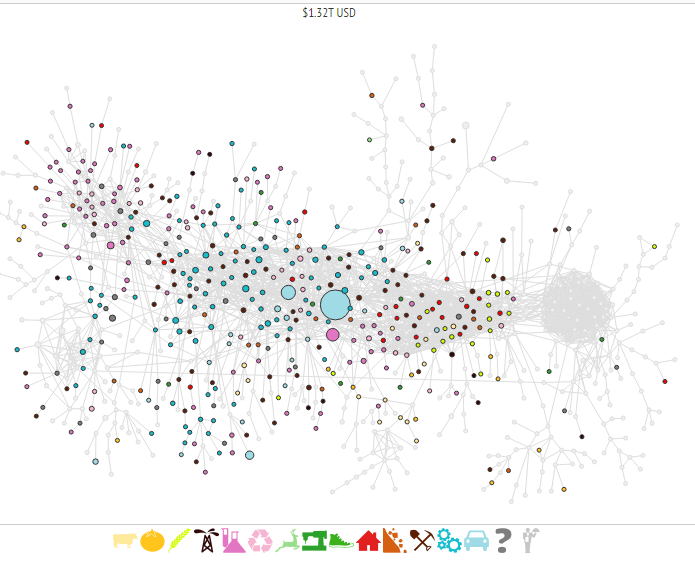
For contrast, the level of complexity and connectedness of the economy of Cambodia: ‒0.65. This country is dominated by low-tech exports (right side of the diagram) of light industry (green). The extreme imbalance of exports is reflected in the negative indicator of connectivity and complexity of the technological space.
Cambodia: ‒0,6503248
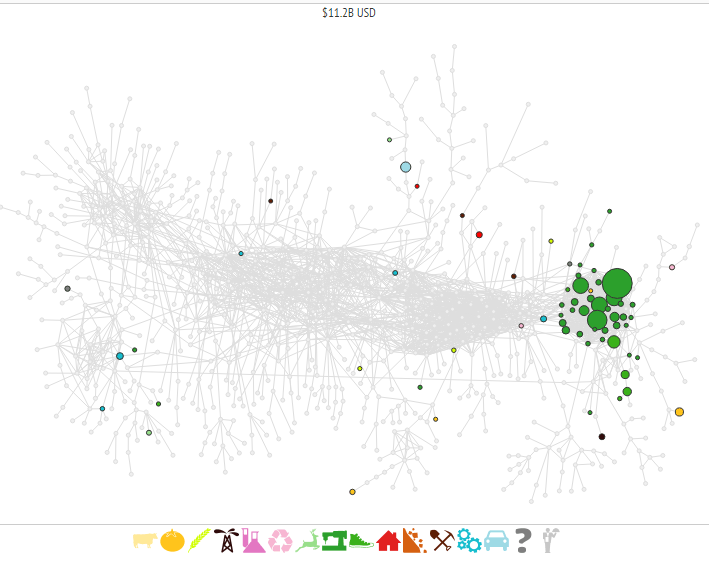
Here are some other countries.
Poland: 0.9321474

Turkey: 0.420847
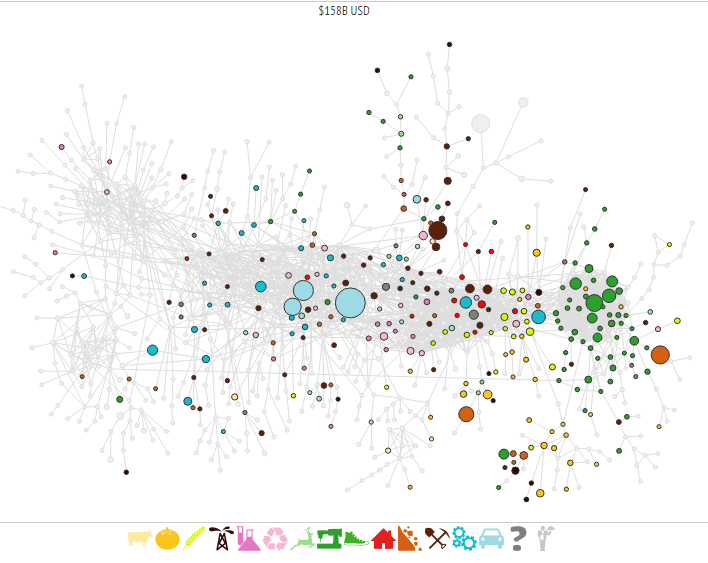
Russia: 0.0518671
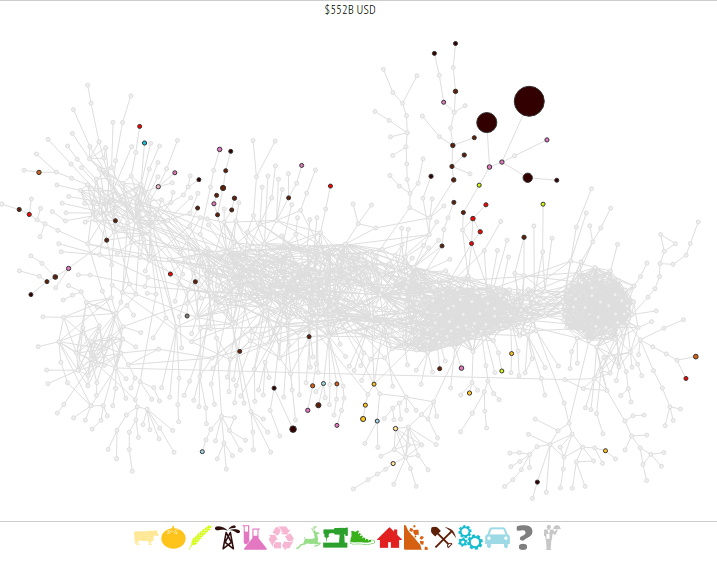
Large stains are oil and gas. Scattered around the perimeter of single points - coal, metals, agriculture, weapons. Aviation industry, shipbuilding, nanoindustry and other "large" projects of recent years are difficult to distinguish with the naked eye. “Our capabilities are spread over the periphery of the technological space, there are no competitive positions in the central hubs,” said Marat Atnaliev, independent analyst and former vice president of Evraz. - The position of the Russian economy in the technological space puts us at 98th place out of 121 in terms of prospects for medium-term economic growth , with a forecast of less than 2% per year, that is, below the world average. And this is based on the 2014 data, that is, without taking into account the decline in oil prices and sanctions. ”
Obviously, the situation should be changed. Especially if Russia wants to become "an exporter, supplier of ideas and technologies for the whole world."
Source: https://habr.com/ru/post/395659/
All Articles